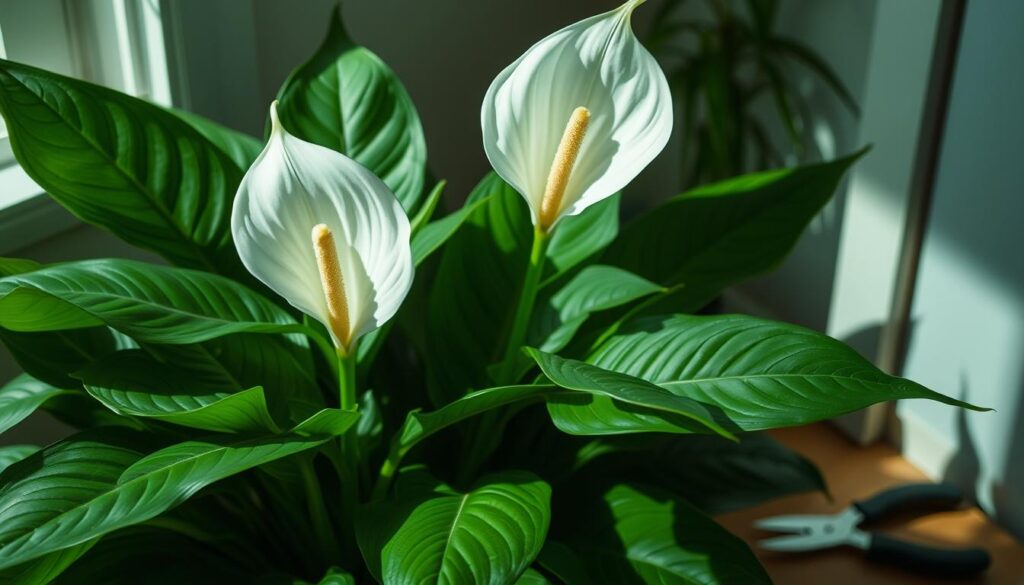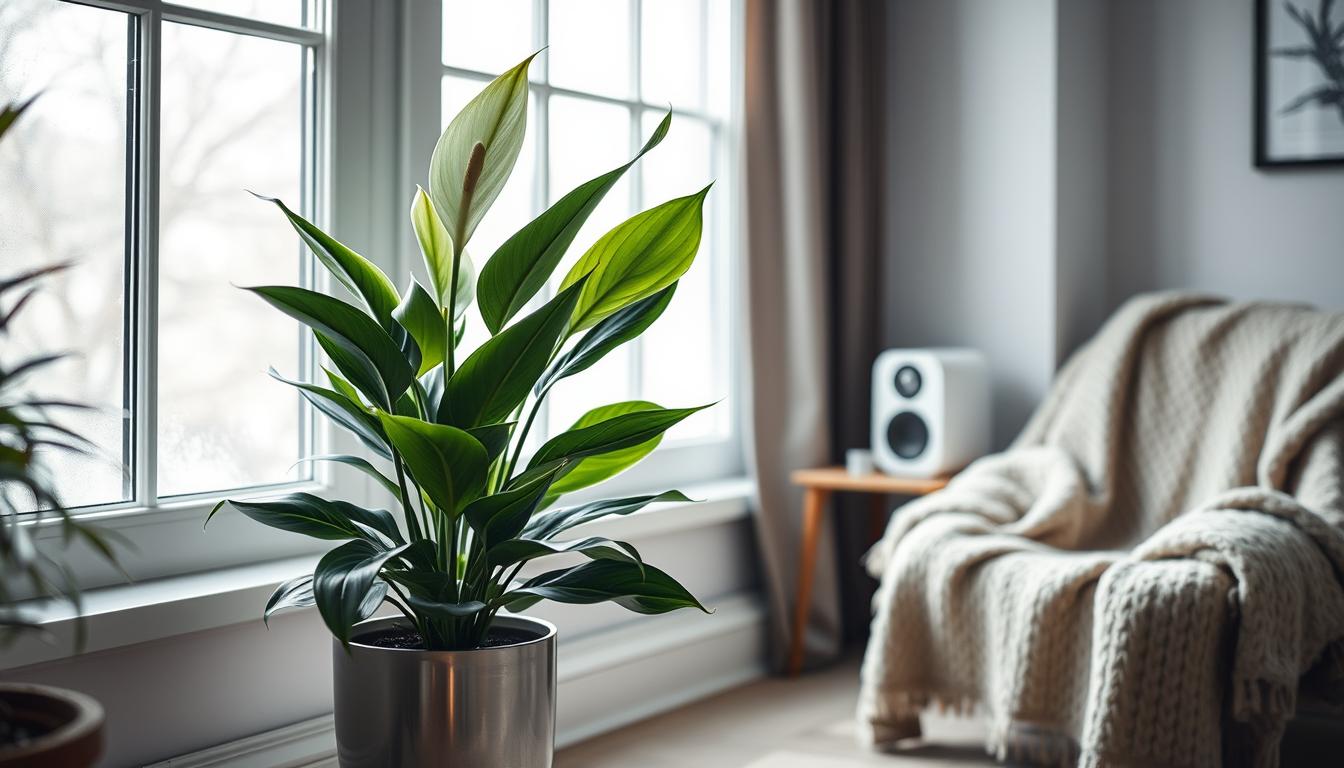As we strive to create a healthier and more comfortable living space, many of us turn to air-purifying plants like the Peace Lily. With its elegant white blooms and ability to remove toxins from the air, it’s no wonder this plant has become a popular choice for indoor spaces. To keep your Peace Lily thriving in cool conditions, it’s essential to understand the unique needs of this beautiful air-purifying plant.
Proper Peace Lily care is crucial, especially in cooler environments. By providing your Peace Lily with the right conditions, you can enjoy its stunning appearance and benefits as an air-purifying plant. Whether you’re a seasoned plant owner or just starting out, this guide will walk you through the ins and outs of Peace Lily care in cool conditions.
Key Takeaways
- Peace Lilies are effective air-purifying plants that can thrive in cool conditions with proper care.
- Understanding the unique needs of your Peace Lily is crucial for its survival and success as an air-purifying plant.
- Peace Lily care in cool conditions requires attention to temperature, watering, and lighting.
- Regular maintenance and troubleshooting can help prevent common issues and keep your Peace Lily healthy.
- By following the right Peace Lily care tips, you can enjoy the beauty and benefits of this air-purifying plant in your home.
- Peace Lily care is a rewarding experience that can bring joy and freshness to your indoor space.
Understanding the Peace Lily Plant
Peace Lily care indoors is relatively easy, and with the right conditions, these plants can thrive. The Peace Lily, or Spathiphyllum, is a popular choice for indoor spaces due to its elegant appearance and air-purifying capabilities. One of the unique features of Peace Lilies is their ability to bloom in low light conditions, making them a versatile choice for any room.
Some of the benefits of having a Peace Lily at home include improved air quality and a touch of natural beauty to the space. Peace Lily care indoors can be simple, as they require minimal maintenance and can survive in a range of conditions. To keep your Peace Lily happy and healthy, it’s essential to understand its needs and provide the right environment.
Unique Features of Peace Lilies
- Ability to bloom in low light conditions
- Air-purifying capabilities
- Low maintenance requirements
Benefits of Having Peace Lilies at Home
Having a Peace Lily at home can bring numerous benefits, including improved air quality and a touch of natural beauty to the space. With proper Peace Lily care indoors, these plants can thrive and provide a range of benefits for years to come.
By understanding the unique features and benefits of Peace Lilies, you can create a thriving and beautiful indoor space that also improves the air quality. With their elegant appearance and low maintenance requirements, it’s no wonder why Peace Lilies are a popular choice for indoor spaces.
Ideal Temperature for Peace Lilies
When it comes to creating a thriving environment for your Peace Lily, temperature plays a crucial role. These air-cleaning indoor plants prefer a specific temperature range to flourish and continue purifying the air effectively. The ideal Peace Lily temperature range is between 65°F to 80°F (18°C to 27°C), making them suitable for most indoor environments.
To ensure your Peace Lily stays healthy, it’s essential to maintain a consistent temperature within this range. Extreme temperatures can cause stress to the plant, leading to yellowing leaves or a lack of blooms. By keeping your Peace Lily in an environment with a stable temperature, you can enjoy the benefits of having these beautiful plants in your home, including their air-purifying properties.
Recommended Temperature Range
The recommended temperature range for Peace Lilies is relatively narrow, but it’s easy to maintain in most homes. Here are some tips to help you keep your Peace Lily within the ideal temperature range:
- Keep your Peace Lily away from drafty windows and doors
- Avoid placing your Peace Lily near heating or cooling vents
- Use a thermometer to monitor the temperature in your home
Signs of Temperature Stress
If your Peace Lily is experiencing temperature stress, you may notice some common signs, including:
- Yellowing leaves
- Lack of blooms
- Wilting or droopy leaves
By recognizing these signs and taking steps to maintain a consistent temperature, you can help your Peace Lily thrive and enjoy the many benefits of having these beautiful air-cleaning indoor plants in your home.
Watering Your Peace Lily
Proper watering is essential for the health and well-being of your Peace Lily. A well-planned Peace Lily watering schedule can help prevent common issues such as root rot and yellowing leaves. To create an ideal watering schedule, consider the environment and the specific needs of your Low-light flowering houseplants.
When it comes to watering, it’s crucial to find the right balance. Overwatering can lead to root rot, while underwatering can cause the leaves to turn yellow. To determine if your plant needs water, you can check the soil moisture by sticking your finger into the soil up to the first knuckle.
Frequency of Watering
The frequency of watering depends on various factors, including the humidity and temperature of the environment. As a general rule, water your Peace Lily thoroughly, allowing the soil to dry slightly between waterings. This will help prevent waterlogged soil and root rot.
How to Check Soil Moisture
To ensure you’re not overwatering or underwatering your Peace Lily, check the soil moisture regularly. You can do this by sticking your finger into the soil up to the first knuckle. If the soil feels dry, it’s time to water. If it’s already moist, you can wait a few more days before watering again.
By following these simple tips and creating a well-planned Peace Lily watering schedule, you can help your Low-light flowering houseplants thrive and enjoy their beautiful blooms and air-purifying benefits.
Light Requirements for Peace Lilies
When it comes to Spathiphyllum light requirements, it’s essential to understand that these plants can thrive in low light conditions, making them an excellent choice for offices or rooms with limited natural light. However, they prefer bright, indirect light to produce the beautiful white blooms.
Peace Lilies are known to be one of the Best plants for offices due to their ability to purify the air and tolerate low light conditions. To ensure your Peace Lily receives the right amount of light, consider placing it near a window with a sheer curtain to filter the direct sunlight.
Optimal Lighting Conditions
To achieve optimal growth, provide your Peace Lily with bright, indirect light. This can be achieved by placing the plant near an east- or west-facing window. Avoid direct sunlight, as it can scorch the leaves.
Effects of Low Light
In low light conditions, Peace Lilies may not produce as many blooms, but they will still maintain their attractive foliage. If you’re looking to add some greenery to a room with limited natural light, a Peace Lily is an excellent choice. With proper care and Spathiphyllum light requirements met, your Peace Lily will thrive and become a beautiful addition to your space.
Fertilizing Your Peace Lily
When it comes to Peace Lily care indoors, fertilization is a crucial aspect to consider. As one of the most popular air-cleaning indoor plants, Peace Lilies require proper nutrients to thrive. A balanced, water-soluble fertilizer can be used during the growing season to provide the necessary nutrients for healthy growth and blooming.
To ensure the best results, it’s essential to follow the instructions on the fertilizer package to avoid overfertilization, which can damage the plant. Here are some tips to keep in mind:
- Use a balanced fertilizer that contains equal amounts of nitrogen, phosphorus, and potassium.
- Fertilize your Peace Lily during the growing season, which typically takes place in the spring and summer months.
- Avoid overfertilization, as this can cause more harm than good to your plant.
Best Fertilizers for Peace Lilies
When choosing a fertilizer for your Peace Lily, look for a balanced, water-soluble formula that is specifically designed for indoor plants. Some popular options include Miracle-Gro and Scotts. By following the instructions and using the right fertilizer, you can help your Peace Lily thrive and enjoy its beautiful blooms and air-purifying benefits.
When and How to Fertilize
To get the most out of your fertilizer, apply it during the growing season, and follow the instructions on the package for the recommended dosage and frequency. With proper fertilization, your Peace Lily will be well on its way to becoming a thriving and beautiful addition to your indoor space, providing you with the benefits of air-cleaning indoor plants.
| Fertilizer Type | Application Frequency | Recommended Dosage |
|---|---|---|
| Balanced, water-soluble fertilizer | During growing season (spring and summer) | Follow package instructions |
Repotting Your Peace Lily
As your Peace Lily grows, its roots will eventually outgrow the container, typically requiring repotting every 1-2 years. This process is essential for the plant’s health and provides an opportunity to inspect the roots, prune them if necessary, and provide fresh soil. Repotting is also a crucial step in Peace Lily propagation, as it allows you to divide the plant and create new ones.
When choosing a new pot, it’s essential to select one that is only slightly larger than the previous one. This prevents the soil from becoming too wet, which can be detrimental to the plant’s health. Some key considerations for repotting include:
- Using a well-draining potting mix to prevent waterlogged soil
- Handling the roots with care to avoid damaging them
- Watering the plant thoroughly after repotting to settle the soil
By repotting your Peace Lily, you can help it thrive and enjoy the benefits of having Low-light flowering houseplants in your home. With proper care and attention, your Peace Lily can continue to purify the air and add beauty to your space.
Pest and Disease Management
Peace Lily care involves more than just watering and fertilizing. It’s essential to keep an eye out for common pests and diseases that can harm your plant. Regular inspection of your Peace Lily can help in early detection, allowing you to take preventative measures to protect your plant. This is especially important if you have Peace Lilies in your office, as they are considered one of the best plants for offices due to their air-purifying properties.
Some common pests that can infest your Peace Lily include spider mites, mealybugs, and scale. These pests can cause damage to your plant, so it’s crucial to take action quickly. To prevent infestations, keep your Peace Lily in a well-ventilated area and avoid overwatering. You can also use insecticidal soap or neem oil to treat infestations.
Preventative Measures
- Keep your Peace Lily in a well-ventilated area
- Avoid overwatering
- Use insecticidal soap or neem oil to treat infestations
By following these tips, you can help keep your Peace Lily healthy and thriving. Remember, Peace Lily care is all about finding the right balance and taking preventative measures to protect your plant from pests and diseases. With the right care, your Peace Lily can continue to purify the air and add beauty to your office or home.
Common Pests and Diseases
| Pest/Disease | Symptoms | Treatment |
|---|---|---|
| Spider Mites | Yellowing leaves, fine webbing | Insecticidal soap or neem oil |
| Mealybugs | White, cottony patches | Insecticidal soap or neem oil |
| Scale | Brown or black bumps on leaves | Insecticidal soap or neem oil |
Increasing Humidity for Peace Lilies
Peace Lily care indoors requires attention to humidity levels, as these air-cleaning indoor plants thrive in environments with relative humidity above 40%. To create an ideal setting for your Peace Lily, it’s essential to understand the importance of humidity and how to increase it.
According to experts in plant care, maintaining the right humidity level can prevent leaf drop and encourage healthy growth. You can increase humidity around your Peace Lily by placing the plant on a tray filled with water and pebbles or using a humidifier.
Methods to Increase Humidity
- Place the plant on a tray filled with water and pebbles
- Use a humidifier to maintain a consistent humidity level
- Group plants together to create a microclimate with higher humidity
By implementing these methods, you can create a humid environment that promotes healthy growth and flourishing of your Peace Lily. Remember to monitor the humidity level and adjust your methods as needed to ensure the best Peace Lily care indoors.
Best Humidity Levels
The ideal humidity level for Peace Lilies is between 40% to 60% relative humidity. You can use a hygrometer to measure the humidity level in your home and adjust your methods accordingly. By maintaining the right humidity level, you can enjoy the benefits of having air-cleaning indoor plants like Peace Lilies in your home.
Pruning and Maintenance
Pruning is a crucial aspect of Peace Lily care, as it helps maintain the plant’s appearance and promotes new growth. By removing dead or dying leaves and flowers, you can prevent the spread of disease and encourage the plant to bloom again. This is especially important for Low-light flowering houseplants like the Peace Lily, which can be more prone to disease in low-light conditions.
When it comes to Peace Lily propagation, pruning can also play a role. By cutting back the plant after it has finished blooming, you can encourage new growth and increase the chances of successful propagation. Here are some tips for pruning your Peace Lily:
- Remove dead or dying leaves and flowers to prevent the spread of disease
- Cut back the plant after it has finished blooming to encourage new growth
- Use sharp, clean pruning tools to prevent spreading disease
Regular pruning and maintenance can help keep your Peace Lily healthy and thriving, even in low-light conditions. By following these tips and doing some research on Peace Lily propagation, you can enjoy the beauty and benefits of these Low-light flowering houseplants for years to come.

Remember to always prioritize your plant’s health and safety when pruning and maintaining your Peace Lily. With the right care and attention, your Peace Lily can thrive and provide you with beautiful blooms and clean air for years to come.
| Pruning Tips | Benefits |
|---|---|
| Remove dead or dying leaves and flowers | Prevents the spread of disease |
| Cut back the plant after blooming | Encourages new growth |
| Use sharp, clean pruning tools | Prevents spreading disease |
Propagating Peace Lilies
Peace Lily care involves not just maintaining the plant, but also propagating it to share with others or to expand your own collection of air-cleaning indoor plants. Propagation can be a rewarding experience, allowing you to enjoy more of these beautiful plants. To start, it’s essential to understand the best methods for propagation.
Peace Lilies can be propagated through division or leaf cuttings. Division involves separating the roots of the plant, while leaf cuttings require taking a section of the leaf and planting it in soil. Both methods can be effective, but they require the right conditions to succeed.
Best Methods for Propagation
- Division: This method involves separating the roots of the plant, making sure each section has at least one growing shoot. This method is best done when repotting the plant.
- Leaf Cuttings: This method involves taking a section of the leaf, removing lower leaves, and planting it in soil. The cutting should be placed in a warm, humid environment to increase the chances of successful propagation.
Ideal Conditions for New Plants
To increase the chances of successful propagation, it’s crucial to provide the right conditions for the new plants. This includes high humidity, warm temperatures, and plenty of light. By following these tips and using the right propagation method, you can enjoy more Peace Lilies and share them with others, spreading the beauty and benefits of these air-cleaning indoor plants.
By understanding how to propagate your Peace Lily, you can help in spreading the benefits of these plants, including their ability to purify the air and create a peaceful environment. With the right Peace Lily care and propagation techniques, you can enjoy these beautiful plants for years to come.
Troubleshooting Peace Lily Issues
As you embark on your journey to care for your Peace Lily, it’s important to be equipped with the knowledge to tackle any potential challenges that may arise. Common issues like yellowing leaves, lack of blooms, and pest infestations can be effectively addressed with the right approach.
By identifying the root cause of the problem, you can swiftly apply the appropriate solutions to restore your Peace Lily to its thriving state. Yellowing leaves, for instance, may indicate overwatering or excessive direct sunlight, while a lack of blooms could signify insufficient light or inadequate fertilization. Understanding these nuances and making the necessary adjustments can work wonders in reviving your air-purifying plant.
With the right care and attention, your Peace Lily will continue to thrive, enhancing the beauty and air quality of your indoor space. By following the guidance provided in this comprehensive guide, you’ll be well on your way to maintaining a healthy, vibrant Peace Lily that will bring joy and serenity to your home for years to come.






Pingback: Vertical Gardening: Thrive in Small Spaces! - Trusted House Plant Guide
Pingback: "ZZ Plant Magic: Easy Steps to Lush, Healthy Growth" - Trusted House Plant Guide
Pingback: 8 Stunning Flowering Indoor Plants to Brighten Your Home - Trusted House Plant Guide
Pingback: 22. How to Grow Fresh Mint Indoors - Trusted House Plant Guide
Pingback: 19. Top 5 Quick-Growing Herbs for Your Indoor Garden - Trusted House Plant Guide
Pingback: 17. How to Grow Aromatic Herbs Indoors for Cooking - Trusted House Plant Guide
Pingback: 11. Companion Planting for Indoor Herbs: What Works Best - Trusted House Plant Guide
Pingback: Managing Humidity for Indoor Plants: What’s Too Much and What’s Not Enough? - Trusted House Plant Guide
Pingback: Indoor Plants Not Growing? Here’s What You Need to Know - Trusted House Plant Guide
Pingback: Creating a Living Wall Art Piece: Unique Ideas for Green Decor - Trusted House Plant Guide
Pingback: Busy Lives, Easy Plants: Top 5 Low-Maintenance Houseplants for the Busy Bee - Trusted House Plant Guide
Pingback: Tropical Plants: Creating and Caring for your Tropical Indoor Plants - Trusted House Plant Guide
Pingback: 10 Best Low-Light Houseplants for a Lush Indoor Oasis - Trusted House Plant Guide
Pingback: 10 Cold-Tolerant Houseplants for Cozy Indoor Spaces - Trusted House Plant Guide
Pingback: The Ultimate Guide to Houseplants: 100 Best Indoor Plants for Every Home - Trusted House Plant Guide
Pingback: Are Houseplants Still Trending in 2025? - Trusted House Plant Guide
Pingback: Essential Winter Care Tips for Your Houseplants
Pingback: Signs of Overwatering: How to Save Your Indoor Plants - Trusted House Plant Guide
Pingback: Crafting Your Own Terrarium: A Beginner's Guide to Greening Your Space - Trusted House Plant Guide
Pingback: "What Are the Best Low Light Indoor Plants? Discover 10 Perfect Varieties. - Trusted House Plant Guide
Pingback: "Unlocking the Secrets of Snake Plants: A Complete Guide to Varieties, Benefits, and Easy Care" - Trusted House Plant Guide
Pingback: Succulent Container Design: Mastering the Art of Container Design - Trusted House Plant Guide
Pingback: 25. How to Prune and Harvest Indoor Herbs for Maximum Yield - Trusted House Plant Guide
Pingback: How to Make a Beautiful Succulent Terrarium: A Step-by-Step Tutorial - Trusted House Plant Guide
Pingback: Plant Decor: Picking a Proven Winner - The Blue Star Fern - Trusted House Plant Guide
Pingback: What are the best low-maintenance indoor plants? - Trusted House Plant Guide
Pingback: Shiny Leaves: How to Clean Your Houseplants for Optimal Growth - Trusted House Plant Guide
Pingback: 8 Houseplant Trends That Will Dominate 2025 – Get Ahead of the Curve! - Trusted House Plant Guide
Pingback: The Ultimate Beginner's Guide to the Most Wanted Indoor Plant for 2025 - Trusted House Plant Guide
Pingback: 10 Perfect Small Houseplants for Compact Spaces - Trusted House Plant Guide
Pingback: 12 Stunning Indoor Succulents and Cacti for Your Home - Trusted House Plant Guide
Pingback: Pure Air, Pure Home: The Ultimate Guide to Air-Purifying Indoor Plants - Trusted House Plant Guide
Pingback: 10 Gorgeous Houseplants That Thrive in Humidity - Trusted House Plant Guide
Pingback: How to Choose the Best Herbs for Indoor Gardening - Trusted House Plant Guide
Pingback: 10. How to Grow Herbs Indoors Without Soil: Hydroponics 101 - Trusted House Plant Guide